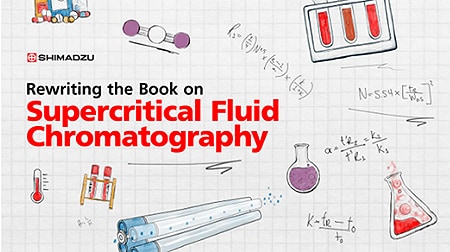Nexera UC
Supercritical Fluid Extraction / Supercritical Fluid Chromatograph
Supercritical Fluid Extraction/Chromatograph System
Preparative scale Nexera™ UC Prep is Here
Advances in column technology have led to a renewed interest in supercritical fluid chromatography (SFC), which uses a supercritical fluid as mobile phase. Compared to liquid, supercritical fluids have low viscosity and high diffusivity. By combining SFC with Supercritical fluid extraction (SFE), which utilizes the high permeability and diffusivity of supercritical fluids, the extraction and analysis of target components from solid samples can be automated. The new analytical technology “Unified Chromatography” improves the analytical workflow by integrating sample extraction, analysis by various separation modes, and high-sensitivity detection.
Rewriting the Book on Supercritical Fluid Chromatography
Supercritical carbon dioxide (CO2) displays the qualities of both a liquid and a gas, making it the ideal choice of mobile phase in supercritical fluid chromatography (SFC). Historically, SFC has been overshadowed by other forms of chromatography such as high-performance liquid chromatography and gas chromatography. However, recent developments in SFC technology have transformed it into a highly accurate, sensitive and cost-effective solution that can outperform other chromatography. With the ability to analyze a range of polar and non-polar molecules, and easily transferable expertise and equipment, it's time to rethink SFC, and discover the advantages of supercritical CO2.
Features
-
The analysis time can be effectively shortened because an excellent chromatographic resolution can be maintained even at higher flow rates than those typically used for HPLC.
-
Separation results can be quickly obtained during method development by screening with both SFC and UHPLC.
-
By using a fraction collector, small-volume fractionation is also possible (ex:1.5 mL vials).
-
Target compounds are extracted from solid samples, and then automatically transferred to SFC.
-
By using SFC, the consumption of organic solvent is reduced by 94.2%, compared to the normal-phase.
Videos
-
SFE-ENANTIOSELECTIVE-SFC-QQQ MS FOR THE DETERMINATION OF CHIRAL PESTICIDES IN HEMP SEEDS
This webinar describes how to develop the analytical method for chiral pesticides in hemp seeds by using online SFE-SFC coupled to triple quadrupole mass spectrometry. Additionally, it will introduce the principle of the on-line SFE-SFC system and how eco-friendly it is.
-
Nexera UC Supercritical Fluid Extraction/Chromatograph System Narration Eddition
-
Overview of the analytical technologies using supercritical fluid
Green Analytical Chemistry (GAC) is a concept of designing analytical methods that are friendly to both chemists and environment. It is necessary for the GAC-based methods to retain the same analytical performance (e.g., accuracy, sensitivity) as those by their conventional counterparts. Large solvent consumption is particularly concerning in a food analysis where complicated sample extraction and chromatography are routinely practiced. Supercritical fluid is a state of matter just like gas or liquid, and the characteristics of CO2 supercritical fluid are nonflammability, easy handling, and low toxicity, which are relevant to the operator safety. This webinar will show the characteristics of supercritical fluids CO2, the practicality of analytical techniques using it, and the applicability to GAC.
-
Method development and Identification of Triacylglycerols species with SFC
Analyzing Triacylglycerols (TAGs) is essential to evaluate the quality and functionality of oils and fats. Chromatographic separation by typical methods that include GC and HPLC might be challenging due to a large number of TAGs species. Supercritical Fluid Chromatography (SFC) is one chromatography method that uses supercritical fluid (i.e. supercritical carbon dioxide) as a mobile phase. Here, we introduce the workflow of method scouting of SFC using Method Scouting Solutions and how to establish the optimized analytical method for TAGs species in natural oils and fats.
News / Events
-
New Technical Report is available, Optimization of Supercritical Fluid Extraction Parameters for Vitamins D2, D3, and K1 from Pharmaceutical Preparations
New Technical Report is available, Optimization of Supercritical Fluid Extraction Parameters for Vitamins D2, D3, and K1 from Pharmaceutical Preparations
-
New Tips & Tricks is available, Automated Dilution and Preparation of Standard and Sample Solutions for Analysis
-
Shimadzu Corporation has released LabSolutions Detect, a software with AI Functionality to support Anomaly Detection for Liquid Chromatographs (LC).
LabSolutions Detect transforms your LC data review process by visualizing differences between accumulated reference data and daily sample data.
-
New Technical Report is available, A sustainable analytical approach for detecting extra virgin olive oil adulteration using Nexera™ UC
In this study, a fast, simple and green methodology was optimized to detect intentionally adulterated extra virgin olive oil EVOO with cheaper seed oils at different levels by means of subcritical fluid chromatography (subFC) with UV detection, followed by statistical analysis.
-
Shimadzu has released the new integrated LC system, i-Series.
The new i-Series integrated LC: Sustainable design. Reliable results. Uncompromising performance.
-
Core-shell Column: Analysis Basics Now Available.
Discover easy-to-understand insights into the fundamentals of analysis.

















